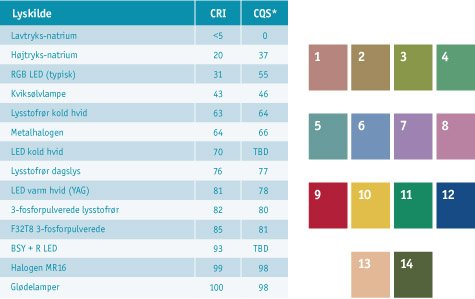What is color reproduction?
A world of light: What is color rendering?
This article is the second in a series of two articles focusing on the fascinating world of the science of light. This article gives you an insight into how to measure color rendering using CRI, Ra or CQS. If you want to know more about what's behind these abbreviations, read on!
When it comes to measuring light in relation to color rendering, there are several different methods you can use. You might think that color rendering is not that important to consider, but color rendering actually has a huge impact on how things are rendered in certain environments. Let's take a closer look at three different types of measurement methods related to color rendering.
CRI, Ra and CQS
CRI stands for color rendering index and can be defined as a quantitative measure of a light source's ability to render different objects compared to natural light. CRI is described as a percentage, and the closer the light source's CRI is to 100%, the better the light source is at rendering objects in a lifelike manner. On average, a light source with a CRI above 80% is considered to have a good ability to reproduce colors.
What is the difference between CRI and Ra? In short, the difference between CRI and Ra is that the Ra index is a measurement based on the 8 standardized colours, while CRI includes 6 additional colours in the measurement. Therefore, CRI is a more detailed form of measurement. Below you can see the Ra index.
However, it is important to note that CRI is gradually becoming an older measurement method for characterizing a light source. Therefore, new measurement methods are constantly emerging that challenge the older CRI measurement method. One of the new measurement methods that is particularly worth mentioning is CQS, color quality scale, which is a modified form of the CRI method. CQS can solve some of the problems that can arise when using the CRI method, which is why the CQS method is increasingly being used by professionals. CQS is particularly good for measuring LED light sources because neither the CRI nor the Ra index work optimally as measurement methods for LEDs. Therefore, CQS can be used as a supplement to the CRI and Ra method. CQS has not yet been approved as a standard, but CQS is a good bet for the standard that will characterize LED measurement in the near future.
The image below shows examples of different CRI and CQS for different light sources used in homes, shops, offices and more. For example, you can see that a warm white LED light source, most commonly used for restaurant and café lighting, has a CRI of 81%, which makes this light source good at reproducing colors. On the other hand, you can also see that neon lights with cold and white light only have a color rendering ability of 63% according to the CRI index, making this light source worse at rendering objects compared to natural light.
If you want to know more about CRI, Ra or CQS, please contact us at Lumega. We can also advise you on how LED can give you the optimal lighting solution, and we can help you find a cost-minimizing and energy-efficient LED solution that fits your needs perfectly.


